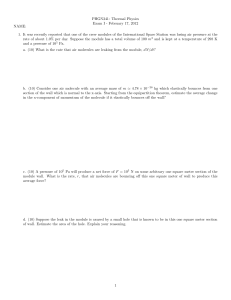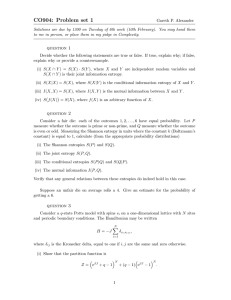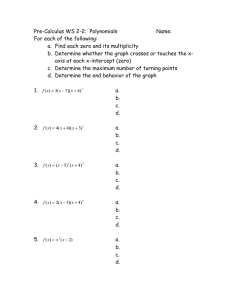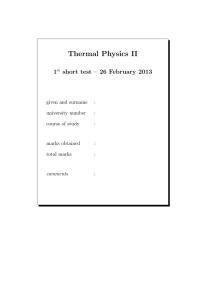PHGN341: Thermal Physics Exam I - February 17, 2012 NAME:
advertisement
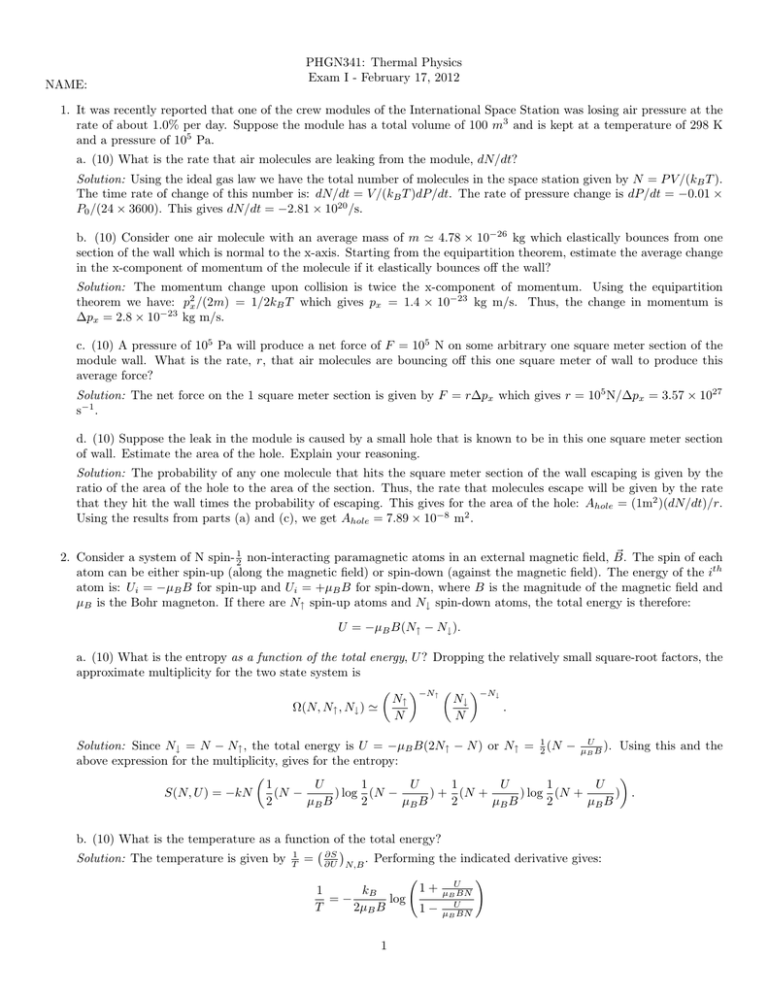
NAME: PHGN341: Thermal Physics Exam I - February 17, 2012 1. It was recently reported that one of the crew modules of the International Space Station was losing air pressure at the rate of about 1.0% per day. Suppose the module has a total volume of 100 m3 and is kept at a temperature of 298 K and a pressure of 105 Pa. a. (10) What is the rate that air molecules are leaking from the module, dN/dt? Solution: Using the ideal gas law we have the total number of molecules in the space station given by N = P V /(kB T ). The time rate of change of this number is: dN/dt = V /(kB T )dP/dt. The rate of pressure change is dP/dt = −0.01 × P0 /(24 × 3600). This gives dN/dt = −2.81 × 1020 /s. b. (10) Consider one air molecule with an average mass of m ' 4.78 × 10−26 kg which elastically bounces from one section of the wall which is normal to the x-axis. Starting from the equipartition theorem, estimate the average change in the x-component of momentum of the molecule if it elastically bounces off the wall? Solution: The momentum change upon collision is twice the x-component of momentum. Using the equipartition theorem we have: p2x /(2m) = 1/2kB T which gives px = 1.4 × 10−23 kg m/s. Thus, the change in momentum is ∆px = 2.8 × 10−23 kg m/s. c. (10) A pressure of 105 Pa will produce a net force of F = 105 N on some arbitrary one square meter section of the module wall. What is the rate, r, that air molecules are bouncing off this one square meter of wall to produce this average force? Solution: The net force on the 1 square meter section is given by F = r∆px which gives r = 105 N/∆px = 3.57 × 1027 s−1 . d. (10) Suppose the leak in the module is caused by a small hole that is known to be in this one square meter section of wall. Estimate the area of the hole. Explain your reasoning. Solution: The probability of any one molecule that hits the square meter section of the wall escaping is given by the ratio of the area of the hole to the area of the section. Thus, the rate that molecules escape will be given by the rate that they hit the wall times the probability of escaping. This gives for the area of the hole: Ahole = (1m2 )(dN/dt)/r. Using the results from parts (a) and (c), we get Ahole = 7.89 × 10−8 m2 . ~ The spin of each 2. Consider a system of N spin- 12 non-interacting paramagnetic atoms in an external magnetic field, B. atom can be either spin-up (along the magnetic field) or spin-down (against the magnetic field). The energy of the ith atom is: Ui = −µB B for spin-up and Ui = +µB B for spin-down, where B is the magnitude of the magnetic field and µB is the Bohr magneton. If there are N↑ spin-up atoms and N↓ spin-down atoms, the total energy is therefore: U = −µB B(N↑ − N↓ ). a. (10) What is the entropy as a function of the total energy, U ? Dropping the relatively small square-root factors, the approximate multiplicity for the two state system is −N↑ −N↓ N↑ N↓ Ω(N, N↑ , N↓ ) ' . N N Solution: Since N↓ = N − N↑ , the total energy is U = −µB B(2N↑ − N ) or N↑ = 21 (N − µBUB ). Using this and the above expression for the multiplicity, gives for the entropy: 1 U 1 U 1 U 1 U S(N, U ) = −kN (N − ) log (N − ) + (N + ) log (N + ) . 2 µB B 2 µB B 2 µB B 2 µB B b. (10) What is the temperature as a function of the total energy? ∂S Solution: The temperature is given by T1 = ∂U . Performing the indicated derivative gives: N,B ! 1 + µBUBN 1 kB =− log T 2µB B 1 − µBUBN 1 c. (10) From your answer in part (b) find the total energy as a function of temperature. Solution: Inverting the expression in part (b) gives: 2µ B − k BT B 1−e = −µB BN tanh µB B U (T ) = −µB BN 2µ B − k BT kB T 1+e B which is the same expression on the equation sheet. 3. Recall that when two systems are in thermal equilibrium, the composite multiplicity is maximal with respect to variation of the energy of either one of the systems. Suppressing the volume and particle number dependence of the multiplicity, the entropy of two systems in thermal contact is: SAB (U, UA ) = k log ΩAB (U, UA ) = k [log ΩA (UA ) + log ΩB (UB = U − UA )] , where U = UA + UB is the total energy (fixed). a. (10) Show that when the two systems are in thermal equilibrium, the entropies satisfy the condition: ∂SA ∂UA = ∂SB ∂UB . AB Solution: Since in equilibrium the total entropy is maximal, then ∂S ∂UA = 0. Since the total entropy is the sum of ∂SA ∂SB the individual entropies, we have ∂U + ∂U = 0. Since the total energy is conserved (i.e. UB = U − UA ), we have A A ∂SA ∂SB ∂ ∂ = − . Thus − = 0. ∂UA ∂UB ∂UA ∂UB b. (10) The Sackur-Tetrode expression for the multiplicity of NA gas atoms of mass, m, confined to volume, VA , is " 3 #NA VA 4πmUA 2 5 Ω(NA , VA , UA ) = e2 NA 3h2 NA where UA is the energy and h is Planck’s constant. Use the entropic definition of temperature to find the internal energy as a function of temperature. Solution: Using the properties of the logarithm function, we can separate the UA -dependence from the other quantities, and the entropy can be written: " 32 #NA 5 V 4πm A SA (UA ) = k ln ΩA (UA ) = k ln U 3NA /2 + ln e2 NA 3h2 NA Taking the derivative gives: 1 ∂SA 3NA 1 = =k . TA ∂UA 2 UA Solving for UA gives the famous equipartion result for an ideal gas: UA = 23 NA k TA . c. (10) Use the entropic definition of pressure to find the pressure as a function of number, volume, and internal energy. ∂ A Solution: The pressure is given by PA = TA ∂S ∂VA = kTA ∂VA (ln Ω(NA , VA , UA )). Using the above expression for the multiplicity, find: " 3/2 # ∂ e5/2 4πmUA 1 PA = NA kT ln VA + ln = NA kTA 2 ∂VA NA 3h NA VA which is the ideal gas law. Using the equipartition result gives: PA VA = 23 UA . 2
